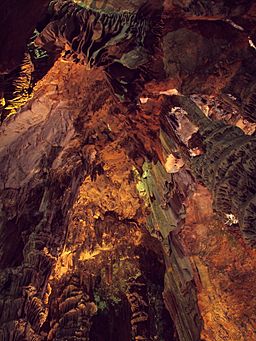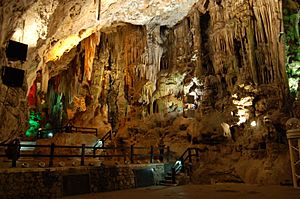St. Michael's Cave facts for kids
Quick facts for kids St. Michael's Cave |
|
|---|---|
| Old St. Michael's Cave | |

Uplit stalactites in St. Michael's Cave.
|
|
| Location | Queen's Road, Upper Rock Nature Reserve, Gibraltar |
| Depth | 62 metres (203 ft) |
| Elevation | 300 metres (980 ft) |
| Geology | Limestone |
| Entrances | 3 |
| Visitors | c. 1,000,000 |
St. Michael's Cave is a famous network of limestone caves located high up on the Rock of Gibraltar. It's part of the Upper Rock Nature Reserve, sitting over 300 meters (about 984 feet) above sea level. The cave got its name from a similar grotto in Italy, where the archangel Michael is said to have appeared.
This cave is the most popular of more than 150 caves found inside the Rock of Gibraltar. Almost 1,000,000 people visit it every year!
Contents
How the Cave Was Made
The cave was formed over thousands of years by rainwater. When rainwater mixes with carbon dioxide in the air and soil, it becomes a weak carbonic acid. This acid slowly seeps through tiny cracks in the limestone rock, dissolving it little by little. Over a very long time, these tiny cracks grew into the large passages and caverns you see today.
Inside the cave, you'll find many amazing stalactites and stalagmites. These formations grow as water drips from the ceiling, leaving behind tiny bits of dissolved rock. Stalactites hang down from the ceiling, and stalagmites grow up from the floor.
Ancient History of the Cave
People have known about St. Michael's Cave for a very long time.
Prehistoric Discoveries
In 1974, a Neolithic bowl was found in the cave, showing that prehistoric humans used this space. More recently, cave art was discovered on one of the walls. It shows an ibex (a type of wild goat) drawn with charcoal. Experts believe this drawing is between 15,000 and 20,000 years old!
Even older than that, two Neanderthal skulls have been found in Gibraltar. This makes it possible that Neanderthals were some of the first to explore the cave around 40,000 BC.
Ancient World Explorers
The first written description of the cave was by a geographer named Pomponius Mela in 45 AD. He described Gibraltar as "A mountain with wonderful hollow spaces, which has its western side almost opened by a large cave that may be entered far into the interior."
However, writings by Homer and other items found in the cave suggest that the ancient Greeks, Romans, and Phoenicians already knew about it.
The Cave's Name and Use Over Time
The name Cueva de San Miguel (which means St. Michael's Cave in Spanish) was first written down by Gibraltar's historian, Alonso Hernández del Portillo. He also suggested the name came from a similar cave in Italy.
Changing Names
After the British took control of Gibraltar in the 1700s, some tried to change the cave's name to St. George's Cave, after the English patron saint. But this new name didn't stick, and people kept using the original name.
Victorian Era Fun
During the Victorian era (the 1800s), St. Michael's Cave became a popular spot for fun events. People held picnics, parties, concerts, and even weddings there! Soldiers would sometimes light up the cave with torches for important visitors, making the stalagmites glow.
Early Archaeology
The first official archaeological dig in the cave happened between 1863 and 1867. A man named Captain Frederick Brome found many prehistoric items, like stone axes, shell jewelry, and bone needles, along with lots of pottery.
Lost Explorers
The cave system is very large, and some explorers got lost. Before 1840, a Colonel Mitchell and another officer went into the caves and were never seen again. This led to big searches in 1840, 1857, and 1865, but they were never found. More explorations happened between 1936 and 1938, but still no sign of the lost officers.
Military Importance
St. Michael's Cave has likely been used for military purposes for a very long time. There was even a defensive wall of Moorish design protecting the entrance.
In 1704, after Anglo-Dutch forces captured Gibraltar, 500 Spanish soldiers hid in the cave overnight. They had climbed up a secret path with the help of a local goatherd named Simón Susarte, planning a surprise attack, but it didn't work out.
World War II Use
During World War II, the entire cave was set up to be an emergency military hospital. Luckily, it was never actually needed for this purpose.
New St. Michael's Cave
In 1942, during World War II, workers were blasting rock to create a new entrance for the emergency hospital. They wanted to improve air flow and create an emergency exit. While doing this, they discovered a whole new, deeper system of caves! This is called New St. Michael's Cave or Lower St. Michael's Cave.
These deeper chambers are filled with almost every type of cave formation you can imagine. There's even an amazing underground lake with crystal clear water.
St. Michael's Cave Today
The Auditorium
The biggest chamber in the cave is called the Cathedral Cave. It's now used as an auditorium because of its amazing natural sound qualities. It has a concrete stage and can seat over 100 people.
Many events happen here, like plays, light and sound shows, and even the annual Miss Gibraltar beauty pageant. The cave also hosts concerts of all kinds, from opera to pop and rock. Famous musicians like Steve Hogarth and Breed 77 have performed here. The Gibraltar World Music Festival is also held here every year.
Visiting the Cave
Today, St. Michael's Cave is one of Gibraltar's most popular tourist attractions. It's open every day, and nearly a million people visit each year. The beautiful cave formations are lit up with colorful lights, and there are displays that tell you about the cave's history.
You can get to St. Michael's Cave by car, taxi, cable car, or even by walking. Your ticket to the cave often includes entry to other major sites on The Rock, like the Moorish Castle and the Great Siege Tunnels.
If you're feeling adventurous, you can even arrange guided tours of Lower St. Michael's Cave through the Gibraltar Tourist Board. This part of the cave is kept in its natural state, but it's fully lit and has ropes to help with climbing. You'll get a safety helmet, and it's a good idea to wear comfortable, non-slip shoes.
Legends of the Cave
St. Michael's Cave is part of some famous legends in Gibraltar.
- The Cathedral Cave was once thought to be bottomless. One popular legend says that the cave is one end of a secret underground tunnel, over 24 kilometers (15 miles) long, that goes all the way under the Strait of Gibraltar. The legend says that the famous Barbary macaques (monkeys) came to the Rock from Morocco through this very tunnel!
- Because the Rock of Gibraltar was believed to be one of the legendary Pillars of Hercules, the Ancient Greeks also thought the cave might be the Gates of Hades, an entrance to the underworld.
Images for kids
See also
 In Spanish: Cueva de San Miguel para niños
In Spanish: Cueva de San Miguel para niños




